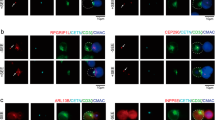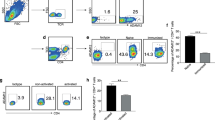Abstract
Protein kinase C-θ (PKC-θ) translocates to the center of the immunological synapse, but the underlying mechanism and its importance in T cell activation are unknown. Here we found that the V3 domain of PKC-θ was necessary and sufficient for localization to the immunological synapse mediated by association with the coreceptor CD28 and dependent on the kinase Lck. We identified a conserved proline-rich motif in V3 required for association with CD28 and immunological synapse localization. We found association with CD28 to be essential for PKC-θ-mediated downstream signaling and the differentiation of T helper type 2 cells (TH2 cells) and interleukin 17–producing helper T cells (TH17 cells) but not of T helper type 1 cells (TH1 cells). Ectopic expression of V3 sequestered PKC-θ from the immunological synapse and interfered with its functions. Our results identify a unique mode of CD28 signaling, establish a molecular basis for the immunological synapse localization of PKC-θ and indicate V3-based 'decoys' may be therapeutic modalities for T cell–mediated inflammatory diseases.
This is a preview of subscription content, access via your institution
Access options
Subscribe to this journal
Receive 12 print issues and online access
$209.00 per year
only $17.42 per issue
Buy this article
- Purchase on Springer Link
- Instant access to full article PDF
Prices may be subject to local taxes which are calculated during checkout







Similar content being viewed by others
References
Dustin, M.L. The cellular context of T cell signaling. Immunity 30, 482–492 (2009).
Dustin, M.L., Chakraborty, A.K. & Shaw, A.S. Understanding the structure and function of the immunological synapse. Cold Spring Harb. Perspect. Biol. 2, a002311 (2010).
Monks, C.R., Kupfer, H., Tamir, I., Barlow, A. & Kupfer, A. Selective modulation of protein kinase C-θ during T-cell activation. Nature 385, 83–86 (1997).
Monks, C.R., Freiberg, B.A., Kupfer, H., Sciaky, N. & Kupfer, A. Three-dimensional segregation of supramolecular activation clusters in T cells. Nature 395, 82–86 (1998).
Pfeifhofer, C. et al. Protein kinase C θ affects Ca2+ mobilization and NFAT cell activation in primary mouse T cells. J. Exp. Med. 197, 1525–1535 (2003).
Sun, Z. et al. PKC-θ is required for TCR-induced NF-κB activation in mature but not immature T lymphocytes. Nature 404, 402–407 (2000).
Hayashi, K. & Altman, A. Protein kinase C θ (PKCθ): a key player in T cell life and death. Pharmacol. Res. 55, 537–544 (2007).
Coudronniere, N., Villalba, M., Englund, N. & Altman, A. NF-κB activation induced by T cell receptor/CD28 costimulation is mediated by protein kinase C-θ. Proc. Natl. Acad. Sci. USA 97, 3394–3399 (2000).
Baier-Bitterlich, G. et al. Protein kinase C-θ isoenzyme selective stimulation of the transcription factor complex AP-1 in T lymphocytes. Mol. Cell. Biol. 16, 1842–1850 (1996).
Altman, A. et al. Positive feedback regulation of PLCγ1/Ca2+ signaling by PKCθ in restimulated T cells via a Tec kinase-dependent pathway. Eur. J. Immunol. 34, 2001–2011 (2004).
Lin, X., O'Mahony, A., Geleziunas, R. & Greene, W.C. Protein kinase C θ participates in NF-κB/Rel activation induced by CD3/CD28 costimulation through selective activation of IκB β (IKKβ). Mol. Cell. Biol. 20, 2933–2940 (2000).
Manicassamy, S., Sadim, M., Ye, R.D. & Sun, Z. Differential roles of PKC-θ in the regulation of intracellular calcium concentration in primary T cells. J. Mol. Biol. 355, 347–359 (2006).
Marsland, B.J., Soos, T.J., Spath, G., Littman, D.R. & Kopf, M. Protein kinase C θ is critical for the development of in vivo T helper Th2 cell but not Th1 cell responses. J. Exp. Med. 200, 181–189 (2004).
Salek-Ardakani, S., So, T., Halteman, B.S., Altman, A. & Croft, M. Differential regulation of Th2 and Th1 lung inflammatory responses by protein kinase C θ. J. Immunol. 173, 6440–6447 (2004).
Salek-Ardakani, S., So, T., Halteman, B.S., Altman, A. & Croft, M. Protein kinase Cθ controls Th1 cells in experimental autoimmune encephalomyelitis. J. Immunol. 175, 7635–7641 (2005).
Anderson, K. et al. Mice deficient in PKC θ demonstrate impaired in vivo T cell activation and protection from T cell-mediated inflammatory diseases. Autoimmunity 39, 469–478 (2006).
Tan, S.L. et al. Resistance to experimental autoimmune encephalomyelitis and impaired IL-17 production in protein kinase C θ-deficient mice. J. Immunol. 176, 2872–2879 (2006).
Berg-Brown, N.N. et al. PKCθ signals activation versus tolerance in vivo. J. Exp. Med. 199, 743–752 (2004).
Giannoni, F., Lyon, A.B., Wareing, M.D., Dias, P.B. & Sarawar, S.R. Protein kinase C θ is not essential for T-cell-mediated clearance of murine gammaherpesvirus 68. J. Virol. 79, 6808–6813 (2005).
Marsland, B.J. et al. Innate signals compensate for the absence of PKCθ during in vivo CD8+ T cell effector and memory responses. Proc. Natl. Acad. Sci. USA 102, 14374–14379 (2005).
Marsland, B.J. et al. TLR ligands act directly upon T cells to restore proliferation in the absence of protein kinase C-θ signaling and promote autoimmune myocarditis. J. Immunol. 178, 3466–3473 (2007).
Valenzuela, J.O. et al. PKCθ is required for alloreactivity and GVHD but not for immune responses toward leukemia and infection in mice. J. Clin. Invest. 119, 3774–3786 (2009).
Keranen, L.M. & Newton, A.C. Ca2+ differentially regulates conventional protein kinase Cs′ membrane interaction and activation. J. Biol. Chem. 272, 25959–25967 (1997).
Huang, J., Sugie, K., La Face, D.M., Altman, A. & Grey, H.M. TCR antagonist peptides induce formation of APC-T cell conjugates and activate a Rac signaling pathway. Eur. J. Immunol. 30, 50–58 (2000).
Tseng, S.Y., Waite, J.C., Liu, M., Vardhana, S. & Dustin, M.L. T cell-dendritic cell immunological synapses contain TCR-dependent CD28–CD80 clusters that recruit protein kinase C θ. J. Immunol. 181, 4852–4863 (2008).
Yokosuka, T. et al. Spatiotemporal regulation of T cell costimulation by TCR-CD28 microclusters and protein kinase C θ translocation. Immunity 29, 589–601 (2008).
Melowic, H.R. et al. Mechanism of diacylglycerol-induced membrane targeting and activation of protein kinase Cθ. J. Biol. Chem. 282, 21467–21476 (2007).
Kay, B.K., Williamson, M.P. & Sudol, M. The importance of being proline: the interaction of proline-rich motifs in signaling proteins with their cognate domains. FASEB J. 14, 231–241 (2000).
Dodson, L.F. et al. Targeted knock-in mice expressing mutations of CD28 reveal an essential pathway for costimulation. Mol. Cell. Biol. 29, 3710–3721 (2009).
Miller, J. et al. Two pathways of costimulation through CD28. Immunol. Res. 45, 159–172 (2009).
Sanchez-Lockhart, M. et al. Cutting edge: CD28-mediated transcriptional and posttranscriptional regulation of IL-2 expression are controlled through different signaling pathways. J. Immunol. 173, 7120–7124 (2004).
Sadra, A. et al. Identification of tyrosine phosphorylation sites in the CD28 cytoplasmic domain and their role in the costimulation of Jurkat T cells. J. Immunol. 162, 1966–1973 (1999).
Hofinger, E. & Sticht, H. Multiple modes of interaction between Lck and CD28. J. Immunol. 174, 3839–3840 (2005).
Liu, Y. et al. Regulation of protein kinase Cθ function during T cell activation by Lck-mediated tyrosine phosphorylation. J. Biol. Chem. 275, 3603–3609 (2000).
Bi, K. et al. Antigen-induced translocation of PKC-θ to membrane rafts is required for T cell activation. Nat. Immunol. 2, 556–563 (2001).
Huang, J. et al. CD28 plays a critical role in the segregation of PKC θ within the immunologic synapse. Proc. Natl. Acad. Sci. USA 99, 9369–9373 (2002).
Acuto, O. & Michel, F. CD28-mediated co-stimulation: a quantitative support for TCR signalling. Nat. Rev. Immunol. 3, 939–951 (2003).
Rudd, C.E., Taylor, A. & Schneider, H. CD28 and CTLA-4 coreceptor expression and signal transduction. Immunol. Rev. 229, 12–26 (2009).
Sanchez-Lockhart, M., Graf, B. & Miller, J. Signals and sequences that control CD28 localization to the central region of the immunological synapse. J. Immunol. 181, 7639–7648 (2008).
Villalba, M. et al. A novel functional interaction between Vav and PKCθ is required for TCR-induced T cell activation. Immunity 12, 151–160 (2000).
D'Ambrosio, D., Cantrell, D.A., Frati, L., Santoni, A. & Testi, R. Involvement of p21ras in T cell CD69 expression. Eur. J. Immunol. 24, 616–620 (1994).
Spitaler, M., Emslie, E., Wood, C.D. & Cantrell, D. Diacylglycerol and protein kinase D localization during T lymphocyte activation. Immunity 24, 535–546 (2006).
Stahelin, R.V. et al. Mechanism of diacylglycerol-induced membrane targeting and activation of protein kinase Cδ. J. Biol. Chem. 279, 29501–29512 (2004).
Carrasco, S. & Merida, I. Diacylglycerol-dependent binding recruits PKCθ and RasGRP1 C1 domains to specific subcellular localizations in living T lymphocytes. Mol. Biol. Cell 15, 2932–2942 (2004).
Thuille, N. et al. Critical role of novel Thr-219 autophosphorylation for the cellular function of PKCθ in T lymphocytes. EMBO J. 24, 3869–3880 (2005).
Colon-Gonzalez, F. & Kazanietz, M.G. C1 domains exposed: from diacylglycerol binding to protein-protein interactions. Biochim. Biophys. Acta 1761, 827–837 (2006).
Boschelli, D.H. Small molecule inhibitors of PKCθ as potential antiinflammatory therapeutics. Curr. Top. Med. Chem. 9, 640–654 (2009).
Holst, J. et al. Generation of T-cell receptor retrogenic mice. Nat. Protoc. 1, 406–417 (2006).
Becart, S. et al. Tyrosine-phosphorylation-dependent translocation of the SLAT protein to the immunological synapse is required for NFAT transcription factor activation. Immunity 29, 704–719 (2008).
Canonigo-Balancio, A.J., Fos, C., Prod'homme, T., Becart, S. & Altman, A. SLAT/Def6 plays a critical role in the development of Th17 cell-mediated experimental autoimmune encephalomyelitis. J. Immunol. 183, 7259–7267 (2009).
Acknowledgements
We thank D. Littman (New York University) for Prkcq−/− mice; T. So, W. Duan and M. Croft for the MCC-specific T hybridoma DCEK fibroblast system and advice on the allergic airway inflammation model; S. Becart, C. Fos and Y. Harada for discussions and suggestions; and K. Hayashi for some of the PKC-θ constructs. Supported by the US National Institutes of Health (CA35299), by The Ministry of Education, Culture, Sports, Science, and Technology, Japan (Grant-in-Aid for Scientific Research on Innovative Areas 'Fluorescence Live imaging' 23113521) and the United States-Israel Binational Science Foundation. This is manuscript number 1392 from the La Jolla Institute for Allergy and Immunology.
Author information
Authors and Affiliations
Contributions
K.-F.K. and A.A. designed the experiments and wrote the manuscript; K.-F.K. generated and analyzed data; T.S. and T.Y. provided expertise in cell imaging; T.S. participated in discussion of the data; T.Y. generated the PKC-GFP and CD28–cyan fluorescent protein fusion vectors; N.I. participated actively in discussions leading to this work and in experimental design; and A.J.C.-B. did various experiments and animal work.
Corresponding author
Ethics declarations
Competing interests
The authors declare no competing financial interests.
Supplementary information
Supplementary Text and Figures
Supplementary Figures 1–9. (PDF 3339 kb)
Rights and permissions
About this article
Cite this article
Kong, KF., Yokosuka, T., Canonigo-Balancio, A. et al. A motif in the V3 domain of the kinase PKC-θ determines its localization in the immunological synapse and functions in T cells via association with CD28. Nat Immunol 12, 1105–1112 (2011). https://doi.org/10.1038/ni.2120
Received:
Accepted:
Published:
Issue Date:
DOI: https://doi.org/10.1038/ni.2120
This article is cited by
-
Counteracting CAR T cell dysfunction
Oncogene (2021)
-
Loss-of-function phenotype of a PKCθT219A knockin mouse strain
Cell Communication and Signaling (2019)
-
Novel mutant mouse line emphasizes the importance of protein kinase C theta for CD4+ T lymphocyte activation
Cell Communication and Signaling (2019)
-
Dynamic regulation of CD28 conformation and signaling by charged lipids and ions
Nature Structural & Molecular Biology (2017)
-
Predominant contribution of DGKζ over DGKα in the control of PKC/PDK‐1‐regulated functions in T cells
Immunology & Cell Biology (2017)



